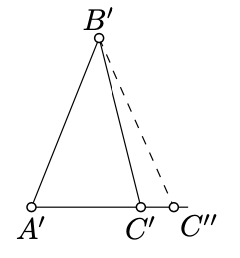4.2: Angle-Side-Angle Condition
- Page ID
- 23599
Assume that
\(AB = A'B'\), \(\measuredangle ABC = \pm \measuredangle A'B'C'\), \(\measuredangle CAB = \pm \measuredangle C'A'B'\)
and \(\triangle A'B'C'\) is nondegenerate. Then
\(\triangle ABC \cong \triangle A'B'C'\).
Note that for degenerate triangles the statement does not hold. For example, consider one triangle with sides 1, 4, 5 and the other with sides 2, 3, 5.
- Proof
-
According to Theorem 3.3.1, either
\[\begin{array} {l} {\meausredangle ABC = \measuredangle A'B'C',} \\ {\measuredangle CAB = \measuredangle C'A'B'} \end{array}\]
or
\[\begin{array} {l} {\meausredangle ABC = -\measuredangle A'B'C',} \\ {\measuredangle CAB = -\measuredangle C'A'B'.} \end{array}\]
Further we assume that 4.2.1 holds; the case 4.2.2 is analogous.

Let \(C''\) be the point on the half-line \([A'C')\) such that \(A'C'' = AC\).
By Axiom IV, \(\triangle A'B'C'' \cong \triangle ABC\). Applying Axiom IV again, we get that
\(\measuredangle A'B'C'' = \measuredangle ABC = \measuredangle A'B'C'\).
By Axiom IIIa, \([B'C') = [BC'')\). Hence \(C''\) lies on \((B'C')\) as well as on \((A'C')\).
Since \(\triangle A'B'C'\) is not degenerate, \((A'C')\) is distinct from \((B'C')\). Applying Axiom II, we get that \(C'' = C'\).
Therefore, \(\triangle A'B'C' = \triangle A'B'C'' \cong \triangle ABC\).


